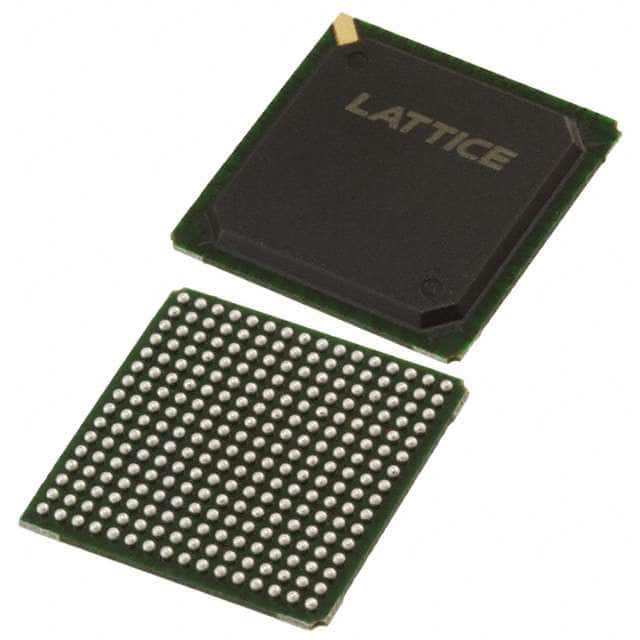LFEC3E-3F256C
Product Overview
Category
LFEC3E-3F256C belongs to the category of Field Programmable Gate Arrays (FPGAs).
Use
This product is primarily used in digital logic circuits for various applications such as telecommunications, automotive, aerospace, and consumer electronics.
Characteristics
- High-performance programmable logic device
- Offers flexibility and reconfigurability
- Provides high-speed data processing capabilities
- Supports complex algorithms and computations
- Low power consumption
- Compact size
Package
LFEC3E-3F256C comes in a compact package that ensures easy integration into electronic systems. The package is designed to provide protection against environmental factors such as moisture, dust, and electrostatic discharge.
Essence
The essence of LFEC3E-3F256C lies in its ability to provide a customizable and versatile solution for implementing complex digital logic circuits.
Packaging/Quantity
LFEC3E-3F256C is typically packaged individually and is available in various quantities depending on the requirements of the user or application.
Specifications
- Logic Elements: 3,000
- Flip-Flops: 256
- Block RAM: 1,080 Kbits
- Maximum Frequency: 500 MHz
- I/O Pins: 256
- Voltage Range: 1.2V - 3.3V
- Operating Temperature: -40°C to 100°C
Detailed Pin Configuration
LFEC3E-3F256C has a total of 256 I/O pins, each serving a specific purpose in the circuit design. The pin configuration includes input/output pins, clock pins, power supply pins, and ground pins. A detailed pinout diagram can be found in the product datasheet.
Functional Features
- Configurable logic blocks for implementing custom logic functions
- Dedicated memory blocks for storing data
- Programmable interconnects for routing signals between different logic elements
- Clock management resources for precise timing control
- Built-in support for various communication protocols
- On-chip debugging and testing capabilities
Advantages and Disadvantages
Advantages
- Flexibility to adapt to changing design requirements
- High-speed data processing capabilities
- Low power consumption compared to traditional ASICs
- Reduced development time and cost due to reprogrammability
- Compact size allows for integration into space-constrained systems
Disadvantages
- Higher cost compared to fixed-function integrated circuits
- Limited performance compared to application-specific designs
- Requires specialized knowledge and tools for programming and configuration
Working Principles
LFEC3E-3F256C operates based on the principles of field-programmable gate arrays. It consists of configurable logic blocks, memory blocks, and programmable interconnects. The device can be programmed using hardware description languages (HDL) or graphical design tools to define the desired logic functions and interconnections. Once programmed, the FPGA executes the specified logic operations, allowing for the implementation of complex digital circuits.
Detailed Application Field Plans
LFEC3E-3F256C finds applications in various fields, including:
- Telecommunications: Used in network routers, switches, and base stations for high-speed data processing and protocol handling.
- Automotive: Employed in automotive electronics for engine control units, advanced driver-assistance systems, and infotainment systems.
- Aerospace: Utilized in satellite communication systems, avionics, and flight control systems for reliable and efficient data processing.
- Consumer Electronics: Integrated into smart TVs, gaming consoles, and wearable devices for multimedia processing and user interface control.
Detailed and Complete Alternative Models
- LFEC5E-5T144C: Offers higher logic capacity and more I/O pins for larger-scale applications.
- LFEC3E-3T144C: Provides a lower-cost alternative with reduced logic capacity and I/O pins, suitable for less complex designs.
- LFEC10E-6F484C: Offers enhanced performance and higher logic density for demanding applications.
These alternative models provide varying levels of performance, capacity, and cost to cater to different design requirements.
Word count: 591 words
10个与LFEC3E-3F256C在技术解决方案中的应用相关的常见问题及解答
Sure! Here are 10 common questions and answers related to the application of LFEC3E-3F256C in technical solutions:
Q: What is LFEC3E-3F256C? A: LFEC3E-3F256C is a specific model of field-programmable gate array (FPGA) manufactured by a company called Lattice Semiconductor.
Q: What are the key features of LFEC3E-3F256C? A: Some key features of LFEC3E-3F256C include high-density programmable logic, low power consumption, and support for various I/O standards.
Q: In what types of technical solutions can LFEC3E-3F256C be used? A: LFEC3E-3F256C can be used in a wide range of technical solutions, including industrial automation, telecommunications, automotive electronics, and medical devices.
Q: How does LFEC3E-3F256C help in industrial automation? A: LFEC3E-3F256C enables the implementation of complex control algorithms, real-time data processing, and integration with various sensors and actuators in industrial automation systems.
Q: Can LFEC3E-3F256C be used in telecommunications applications? A: Yes, LFEC3E-3F256C can be used in telecommunications applications such as baseband processing, network packet processing, and signal modulation/demodulation.
Q: Does LFEC3E-3F256C support low power consumption? A: Yes, LFEC3E-3F256C is designed to have low power consumption, making it suitable for battery-powered devices or energy-efficient applications.
Q: What I/O standards are supported by LFEC3E-3F256C? A: LFEC3E-3F256C supports various I/O standards, including LVCMOS, LVTTL, LVDS, and SSTL.
Q: Can LFEC3E-3F256C be used in automotive electronics? A: Yes, LFEC3E-3F256C can be used in automotive electronics for applications such as advanced driver assistance systems (ADAS), engine control units (ECUs), and infotainment systems.
Q: How does LFEC3E-3F256C benefit medical devices? A: LFEC3E-3F256C enables the implementation of complex algorithms, real-time signal processing, and integration with various sensors in medical devices like patient monitoring systems or diagnostic equipment.
Q: Are there any development tools available for LFEC3E-3F256C? A: Yes, Lattice Semiconductor provides development tools like software design kits (SDKs) and integrated development environments (IDEs) to facilitate the design and programming of LFEC3E-3F256C-based solutions.
Please note that the specific applications and features mentioned above are for illustrative purposes and may vary depending on the actual requirements and use cases.


